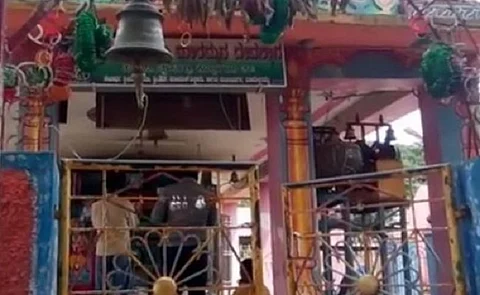

The Karnataka government has directed that all temples under the Hindu Religious Institutions and Charitable Endowments Department, often called the Muzrai department, perform special pooje and offer prayers on January 22 — the day on which the Ram temple in Ayodhya is to be consecrated. This decision, announced by the Muzrai Minister Ramalinga Reddy, is against the state’s religious diversity.
“All Muzrai temples across the state will perform mahamangala arathi at the same time during the consecration of the Ram temple in Ayodhya,” Muzrai Minister Ramalinga Reddy said on Saturday. This directive is against the spirit of “sarva janangada shantiya thota” which was the title of the Congress’ manifesto ahead of the state elections. How appropriate is the government’s diktat that all Muzrai temples offer prayers to one particular god at a specified time when innumerable communities have their own traditions of worship?
The worship of Rama is a Vaishnava tradition. This has prompted many to ask why Shaivite temples administered by the Muzrai department should offer worship when a Ram temple is being consecrated. There is already a huge debate in the state over whether Muzrai temples should follow Shaivite or Vaishnava rituals. Given this state of affairs, ordering that pooje be conducted to the god Ram — a Vaishnavaite god — in Shiva and Shudra temples or daivasthanas, goes against the traditions of these temples.
The Kukke Subramanya Temple in Sullia, Dakshina Kannada district, is one of the most prominent Muzrai temples. On March 21, 2021, a committee of the temple’s devotees held a press conference expressing indignation that despite it being a Shaivite temple, the archakas (priests) were worshipping Vishnu by conducting the antaryami pooje. When such controversies still continue, it is not right to order that prayers be offered in Kukke Subramanya temple when a Rama temple is being consecrated.
There is already much debate about Vishnu worshippers being part of Shiva temples. Examples of such conflicts have been recorded by researchers such as Dr Ma Su Achyut Sharma in his 1969 book Udupi Kshetrada Charitrika Hinnele, about Udupi’s famous temple. In the Madananteshwara chapter, he says, “Before the Madhwa Brahmins arrived in Udupi, the Ananteshwara temple was in the hands of the Sthanika Shiva Brahmins. The Madhwa Brahmins drove away the Shiva Brahmins with the help of the local Bunts, took control of the Ananteswara temple and called it an Anantaasana temple. Then, they deliberately damaged the Ananteshwara Shivalinga and to hide it, covered it with a sheet of copper. Now, in this abode of Shiva, the Bilva leaves and vibhuti which are dear to Ishwara have been replaced by tulasi-gandha (tulasi-sandalwood) which are Vaishnavite worship practices.” Even today, there is an objection to tulasi-gandha being given to devotees instead of vibhuti in Shiva temples where Madhwa Brahmins are priests. In such a scenario, how is it alright for pooje to be offered to Rama in a Shiva temple?
Numerous bhootaradhana daivasthanas too fall under the Muzrai department. They have their own Shudra / Dalit forms of worship in which Vedic rituals have no place. There is no concept of a mahamangala arathi in bhootaradhane; daivasthanas do not even have the utensils in which arathi is offered. There is no concept of offering fire to the deity; rather it is smoke which is offered to the deities using elongated torches. Therefore, it is not at all possible for daivasthanas under the Muzrai department to comply with the government’s order.
Many Chowdeshwari temples in north Karnataka and Annamma temples in and around Bengaluru fall under the Muzrai department. What connection do Chowdeshwari and Annamma have with Rama or a temple dedicated to Rama?
In reality, traditions such as those of Maramma, Annamma, Muni pooje, and bhootaradhane are to be found across Karnataka. Many of the communities that follow these “little traditions” also worship Shiva.
For instance, there is a festival called pursa pooje among the Malekudiyas which is associated with Shiva. According to the story, when Shiva looked around his temple atop Kadri hill in Mangaluru, he noticed that people everywhere worshipped him, except for the Malekudiyas who lived in the forest. He looked more closely to find out why they were the only ones not offering him prayers, and realised that the Malekudiyas were busy working. So, Shiva and Parvati set out to visit them but in disguise. They assumed the form of Koraga and Korapalti — a man and woman of the Koraga community, who are considered “untouchable” even by the “untouchables.” In that form, they visited the Malekudiyas, and eventually, the Malekudiyas too began to worship Shiva through their own ritual: the pursa pooje.
Such associations with Shiva appear even in the stories of Annappa, a deity that finds a spot in the Shri Kshetra Dharmasthala; in the stories of Siri, a female deity and the daiva Panjurli of coastal Karnataka. Many other communities too have their own ties to Shiva, the most prominent of which are the Lingayats.
Perhaps people consider Shiva as their own god because they feel that they are not “untouchable” for Shiva. Such stories about Vishnu are rare if they do exist, it is because Vishnu usually takes the form of a Brahmin when he disguises himself.
People perceive these two gods differently because Shankaracharya’s advaita philosophy which is associated with Shaivism did not distinguish the self as different from god. Madhwacharya’s dwaita philosophy, on the other hand, advocated that the god is different from the self.
When religious sentiments are so complex, the government’s insistence that Rama — a Vaishnava god — must be worshipped in Shiva temples and places of worship of Shudras and Dalits, is nothing short of imposition.
Naveen Soorinje is a senior Kannada journalist. This piece was translated by Anisha Sheth.